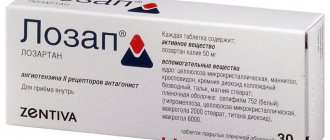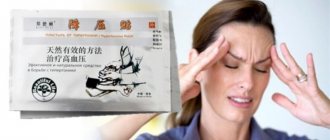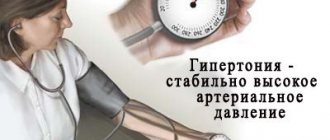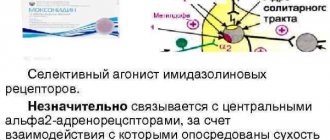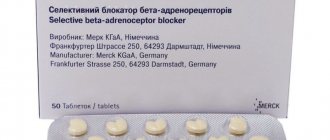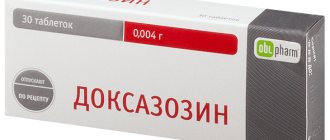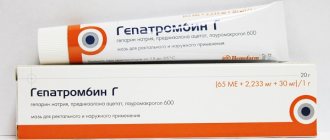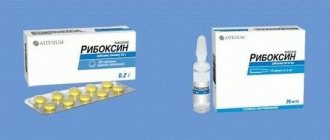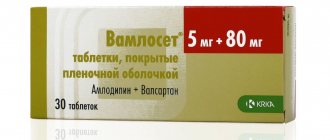Release form and composition
Physiotens is available in the form of film-coated tablets:
- dosage 0.2 mg: round, biconvex, pale pink, with “0.2” engraved on one side, white on the break (14 pieces in blisters, 1, 2 or 7 blisters in a cardboard package);
- dosage 0.3 mg: round, biconvex, pink, with “0.3” engraved on one side, white on the break (14 pieces in blisters, 1, 2 or 7 blisters in a cardboard package);
- dosage 0.4 mg: round, biconvex, brownish-pink, with “0.4” engraved on one side, white on the break (14 pieces in blisters, 1, 2 or 7 blisters in a cardboard package).
Composition of 1 tablet:
- active ingredient: moxonidine – 0.2; 0.3 or 0.4 mg;
- auxiliary components: povidone, magnesium stearate, lactose monohydrate, crospovidone;
- film shell: ethylcellulose, talc, hypromellose, titanium dioxide, macrogol, red iron oxide dye.
general characteristics
The drug belongs to the group of antihypertensive drugs, imidazoline receptor agonists. Has a central effect on the nervous system.
Operating principle
Physiotens helps to quickly lower blood pressure. The effect is achieved due to the properties of its active component – moxonidine. Once in the body, it acts in several directions at once:
selectively stimulates imidazoline receptors located in the brain stem;- inhibits the release of catecholamines, reducing their effect on blood vessels and heart muscle;
- suppresses the activity of sympathetic nervous regulation in relation to the myocardium, kidneys and intestines;
- has a slight calming effect;
- reduces insulin resistance;
- reduces peripheral vascular resistance.
Unlike other antihypertensive drugs, Physiotens has no affinity for alpha2-adrenergic receptors. The drug does not significantly affect the force of myocardial contraction and heart rate, and rarely causes a feeling of dry mouth.
Release form, composition
The medicine is produced in the form of tablets. Tablets are placed in contour cells of 14 pieces. The number of blisters in a package is 1, 2 or 7. Their shape is round, biconvex, and the color varies from light pink to red. The top of the tablets is coated. Each of them contains 0.2, 0.3 or 0.4 mg of the active ingredient (moxonidine). Its other components:
- red iron oxide;
- povidone;
- lactose monohydrate;
- crospovidone;
- hypromellose;
- titanium dioxide;
- magnesium stearate;
- ethylcellulose;
- macrogol 6000;
- talc.
Pharmacokinetics
Physiotens is quickly and almost completely absorbed in the intestine. Its bioavailability is 88%. The pharmacokinetics of the drug is not affected by food intake.
Brief characteristics of the drug
The active substance of the drug binds to plasma proteins by 7.2%. Its concentration in the blood is highest an hour after administration. The main metabolism of the drug occurs in the digestive tract. The products of its metabolism are completely eliminated from the body within 24 hours naturally - along with urine and feces. The half-life of the drug in patients with renal failure may increase.
Cost in pharmacies in Russia and Kazakhstan
To purchase the drug, you must provide the pharmacist with a doctor's prescription. The price depends on the country of origin, the region of its sale and the dosage of the active ingredient. Average prices are shown in Table. 1.
Table 1 - Cost in Russia
| Location of pharmacies in Russia that offer Physiotens | Manufacturer | Cost of drug packaging (14 tablets), rub. | |
| Active substance content, mg | |||
| 0,2 | 0,4 | ||
| Moscow | Abbott Laboratories (Germany) | 279 | 436 |
| Krasnoyarsk | 441 | ||
| Saint Petersburg | 291 | 449 | |
| Krasnodar | 286 | 444 | |
| Novosibirsk | 293 | 451 | |
| Kazan | 281 | 437 | |
| Permian | 302 | 463 | |
| Ufa | 280 | 438 | |
On the Russian pharmacological market, the price of the drug is approximately at the same level. The cost of 14 tablets is the lowest in Moscow, the highest in Perm.
The price of an antihypertensive drug in pharmacies in Kazakhstan, just as in Russia, may differ depending on the region. Table. 2.
Table 2 – Cost in Kazakhstan
| Region of sale Physiotensa | Manufacturer | Cost of 14 tablets with 0.4 mg moxonidine, tg |
| Almaty | Solvey Pharmaceuticals (Germany) | 2892 |
| Astana | 3220 | |
| Aktobe, Uralsk | Almaty pharmaceutical factory (Kazakhstan) | 3340 |
| Pavlodar | 3620 | |
| Karaganda | Mailan Laboratories, France | 2920 |
Pharmacological properties
Pharmacodynamics
Physiotens is a centrally acting antihypertensive drug. It selectively stimulates receptors that take part in the reflex and tonic regulation of the sympathetic nervous system. Due to stimulation of imidazoline receptors, peripheral sympathetic activity is reduced and blood pressure is reduced.
Moxonidine differs from other sympatholytic drugs for lowering blood pressure by its lower affinity for alpha2-adrenergic receptors, which reduces the likelihood of dry mouth and sedation.
As a result of taking Physiotens, systemic vascular resistance and blood pressure decrease. The antihypertensive effect of the drug has been confirmed by a number of studies (placebo-controlled, double-blind and randomized studies).
In patients with obesity, moderate arterial hypertension and insulin resistance, moxonidine improves the insulin sensitivity index by 21% (compared to placebo).
Pharmacokinetics
After oral administration, the drug is quickly and almost completely absorbed in the upper digestive tract. Bioavailability of moxonidine ~ 88%. The maximum concentration is reached after approximately 1 hour. When taken simultaneously with food, the pharmacokinetics of the drug does not change. Moxonidine is 7.2% bound to plasma proteins.
As a result of drug metabolism, dehydrogenated moxonidine (the main metabolite) is formed. Its pharmacodynamic activity is approximately 10% of that of moxonidine.
The half-life of moxonidine is 2.5 hours, and its metabolite is 5 hours. During the day, more than 90% of the drug is excreted by the kidneys (78% unchanged, 13% in the form of dehydrogenated moxonidine and about 8% in the form of other metabolites). Less than 1% of the dose taken is excreted through the intestines.
In patients with arterial hypertension, the pharmacokinetics of Physiotens do not change compared to healthy volunteers.
In elderly patients, pharmacokinetic parameters change slightly.
The drug is not recommended for use in children and adolescents under 18 years of age (special studies of the pharmacokinetics of moxonidine in this group of patients have not been conducted).
The elimination of the drug depends on creatinine clearance. In patients with creatinine clearance in the range of 30–60 ml/min (moderate renal failure), the steady-state plasma concentrations and terminal half-life of moxonidine are approximately 2 and 1.5 times higher than those in patients with normal renal function (with creatinine clearance greater than 90 ml/min). In severe renal failure (creatinine clearance less than 30 ml/min), steady-state plasma concentrations and terminal half-life are 3 times higher than in patients with normal renal function. When multiple doses of the drug are prescribed to patients with moderate to severe renal failure, a predictable accumulation of moxonidine occurs. When creatinine clearance is less than 10 ml/min (end-stage renal failure, the patient is on hemodialysis), steady-state plasma concentrations and terminal half-life are, respectively, 6 and 4 times higher than in patients with normal renal function. In all of these groups of patients, the maximum plasma concentration of the drug is 1.5–2 times higher than in patients without impaired renal function, therefore the dosage of Physiotenza should be selected on an individual basis. During hemodialysis, the excretion of moxonidine is insignificant.
Medicine Physiotens
High blood pressure occurs in many people, especially those at risk due to age and genetic predisposition. Physiotens tablets are recommended for patients suffering from second and third degree hypertension, especially if the disease is aggravated by obesity, erectile dysfunction in men, anorgasmia or cycle failure in women. Thanks to the administration of the drug, a decrease in insulin resistance is observed. The medicine not only reduces blood pressure, but also improves cerebral circulation.
Composition and release form
The main active ingredient is moxonidine. Additional components are lactose, cellulose ethyl ether, magnesium stearate, povidone, iron oxide, titanium dioxide, macrogol - these components improve the absorption of the base treatment compound and facilitate the excretion of metabolites. Physiotens blood pressure tablets are available in various dosages, depending on the recommended dose of moxonidine.
| Pills | Moxonidine content |
| Physiotens – 200 | 200 mcg |
| Physiotens - 300 | 300 mcg |
| Physiotens – 400 | 400 mcg |
Pharmacodynamics and pharmacokinetics
The drug is part of the group of central antagonists of imidazoline receptors, which are responsible for the tonic, reflex regulation of the sympathetic nervous system, including hypertension due to the malfunction of these receptors. When entering the human body, the components bind to adrenergic receptors and reduce the activity of the secretion of the hormone adrenaline. As a result, the drug has the following positive effects:
- Corrects arterial hypertension, having a pronounced hypotensive effect. Physiotens is considered the first choice drug for hypertensive crisis.
- Normalizes the sympathetic activity of the nervous system.
- During long-term use, it strengthens myocardial vessels, kidneys, and intestinal walls.
- Helps lower blood sugar and improve overall health - relieves dizziness, angina, acts as a mild diuretic.
- Does not have a sedative effect, does not cause drowsiness, or impaired concentration.
Absorption is up to 90%. Metabolites are excreted in the urine, 80% unchanged. The full withdrawal cycle is 24 hours. About one percent of metabolites are excreted in the feces. Residual substances do not accumulate in the body and do not produce long-term effects on organ systems. In elderly patients, minor variations may occur due to metabolic changes, but the variations are not considered clinically significant.
Article on the topic: Treatment of shoulder periarthritis with medications, physiotherapy and folk remedies
Indications for use
For a single episode of hypertension, doctors do not prescribe Physiotens - the instructions for its use imply that it should be taken only in case of pronounced changes in the body against the background of a chronic increase in pressure. The dose is determined by the attending physician; self-prescription of this medicine is unacceptable. The main indications are arterial hypertension of the second and third stages, obesity and diabetes mellitus as additional diseases. The drug is especially relevant if beta-blockers are ineffective.
Contraindications
Absolute:
- severe bradycardia (resting heart rate less than 50 beats per minute);
- sick sinus syndrome;
- lactase deficiency, hereditary galactose intolerance, glucose/galactose malabsorption syndrome;
- children and adolescents up to 18 years of age;
- hypersensitivity to any component of the drug.
Relative (Physiotens is used with caution):
- severe renal failure;
- end-stage renal failure;
- hemodialysis;
- severe liver failure.
Side effects
Instructions for use indicate the main contraindications when prescribing the drug:
- individual sensitivity to the drug and its components,
- also bradycardia,
- pathology of the sinus node.
At the same time, taking Physiotens can worsen the health status of patients so much that they lose consciousness, and sometimes death is possible.
Physiotens is not prescribed for acute and chronic heart failure, in childhood, as well as for women during pregnancy and nursing mothers. In cases of severe renal failure, the medicine is also contraindicated in patients. If the drug Physiotens is not accepted, patients experience:
- allergic manifestations in the form of rash spots,
- digestive disorders, possible constipation or diarrhea,
- headache,
- feeling of dry mouth,
- headache.
Angioedema can be a serious complication. Usually, side effects appear at the beginning of taking the drug, so in this situation, doctors closely monitor patients and evaluate the specifics and severity of side effects.
As the research results demonstrate, with minor side effects there is hope for the body to adapt to the drug, after which the negative phenomena disappear and do not bother patients. The same studies show that type 2 diabetics suffered the most from side effects, but other participants in the experimental group in which the drug was tested tolerated its use well.
If for any reason the patient took a larger dose of Physiotens than recommended, and his blood pressure dropped to low levels, it is necessary to call an ambulance. For example, alcohol enhances the hypotensive effect. Since there is no specific antidote, when the blood pressure drops critically, doctors give patients a drip with saline and inject dopamine; when the pulse slows down, atropine injections are indicated.
Directions for use and dosage
The tablets are taken orally, regardless of food. As a rule, the initial dose of the drug is 1 tablet of 0.2 mg once a day.
Maximum doses of Physiotens: single – 0.4 mg, daily – 0.6 mg in two doses.
For patients with moderate or severe renal failure, as well as for patients on hemodialysis, the drug is prescribed at an initial daily dose of 0.2 mg. If necessary and if the drug is well tolerated, the daily dose can be increased to 0.4 mg.
What to replace it with?
If necessary, Physiotens is replaced with drugs that have the same composition or have similar properties.
Russian and imported structural substitutes
There are many structural analogues of Physiotens on the pharmacological market, differing in manufacturer and price. The main ones are presented in Table. 4.
Table 4 - Structural substitutes
| Manufacturer | Analogue of Physiotenza according to the active substance | a brief description of | Cost, rub. |
| Russia | Moxonidine | It is used in the same cases as Physiotens, but compared to it, it has more side effects. Available in tablets containing 0.2 mg of active substance, castor oil, magnesium stearate, Tween-80, Klucel, Aerosil. | 124-309 |
| Moxarel | Stops a sharp and persistent increase in blood pressure, has a positive effect on carbohydrate metabolism, and helps reduce blood glucose levels. Available in tablets containing 0.2, 0.3 and 0.4 mg of moxonidine. | 100-320 | |
| Moxonidine C3 | Normalizes blood pressure by reducing the activity of the peripheral sympathetic nervous system. Contains from 0.2 to 0.4 mg of active substance. Not prescribed for hemodialysis, children, patients over 75 years of age, during pregnancy and breastfeeding. | 70-260 | |
| Israel | Tenzotran | They have the same properties as Physiotens, but have more contraindications. The list of restrictions for use also includes: history of angioedema, atrioventricular block (except first degree), metabolic disorders. Available in tablets. Each contains 0.2, 0.3 or 0.4 mg moxonidine. | 165-660 |
| Germany | Moxogamma | 128-300 | |
| Spain | Tsint | Has a pronounced hypotensive effect. Can be prescribed to children over 16 years of age. Presented in the form of tablets containing 300 mcg of active substance. They are packaged in blisters of 10 or 14 pieces. | 125-220 |
Structural analogues of Physiotens differ in price and amount of active substance, but have similar properties. In fact, these are the same drug, but with a different trade name.
Drugs with a similar principle of action
The list of Physiotens analogues that have a similar effect includes:
- Rilmenidine is a drug that belongs to the group of agonists of central and peripheral imidazoline receptors. Its main active substance is rilmenidine dihydrogen phosphate. Release form: tablets. Recommended for primary and secondary hypertension. Not prescribed for children, pregnant and nursing mothers. You can purchase the product for 720-750 rubles.
Albarel is an antihypertensive drug, an oxazoline derivative. Presented in the form of tablets that contain 1 mg of rilmenidine. The average cost of the drug is 780-900 rubles.- Dopegit is part of the group of alpha2-adrenergic stimulants. Prescribed to patients with mild to moderate hypertension. Can be used during pregnancy. Available in tablets. Each contains 250 mg of methyldopa sesquihydrate (active ingredient). The cost of Dopegit is from 220 rubles.
The possibility of replacing Physiotens with structural analogues and drugs with a similar principle of action should be discussed with your doctor. Only a specialist can select an effective medicine for high blood pressure and correctly determine its dosage.
Overdose
In case of an overdose of the drug, the following symptoms may occur: dizziness, headache, dry mouth, drowsiness, fatigue, vomiting, marked decrease in blood pressure, bradycardia, pain in the epigastric region, sedation, asthenia. A transient increase in blood pressure, hyperglycemia and tachycardia may potentially occur.
There is no specific antidote. Symptomatic therapy is carried out: bradycardia - with atropine, critical level of hypotension - with dopamine, paradoxical hypotensive effects are stopped with alpha-adrenergic receptor antagonists.
Several cases of Physiotens overdose have been reported, when doses up to 19.6 mg were used once (no fatal outcome was observed).
Side effects of Physiotenza
Even if the medicine was prescribed by a doctor, negative reactions of the body, both to a single dose and to a systemic one, cannot be ruled out. They can follow from the nervous system, cardiovascular, digestive, musculoskeletal and more. The full list of adverse reactions mentioned in the official instructions is as follows:
- headache;
- dizziness;
- drowsiness;
- loss of consciousness (rare);
- dry mouth;
- nausea;
- vomit;
- diarrhea;
- dyspeptic symptoms;
- skin rash;
- skin itching;
- angioedema (rare);
- sleep disorders;
- ringing in the ears (rare);
- pain in the spine (rarely in the cervical region);
- asthenia;
- increased nervousness (rare);
- severe decrease in blood pressure.
special instructions
When using Physiotens and beta-blockers simultaneously, and it is necessary to cancel the latter, beta-blockers should first be discontinued and only after a few days Physiotens is canceled.
During treatment, it is necessary to regularly monitor heart rate, blood pressure and electrocardiogram. Discontinuation of the drug should be carried out gradually.
Impact on the ability to drive vehicles and complex mechanisms
Special studies on the effect of Physiotens on the ability to drive vehicles and work with potentially dangerous mechanisms have not been conducted.
Considering the possible development of dizziness and drowsiness during drug therapy, it is recommended to exercise caution when performing work that requires increased concentration and high reaction speed.
Indications for use of the drug and its effect
Like any other medication, Physiotens has indications for use. Pathologies for which doctors prescribe the drug are presented in this list:
- Hypertonic disease.
- High blood pressure in patients with type 2 diabetes mellitus.
- Metabolic syndrome.
It is noteworthy that with the help of Physiotens it is actually possible to increase blood pressure for 6, 12 or more hours, up to one day. The drug also helps with high blood sugar. This happens due to the sensitivity of cells to insulin.
The hypotensive effect of the drug is possible due to its effect on imidazoline receptors. Such sensitive endings are located in the brain and they are divided into three types according to the type of their action:
- receptors of the first group are responsible for normalizing the activity of the sympathetic nervous system,
- receptors of the second group are able to influence the production of adrenaline and norepinephrine,
- the third group of receptors controls the production of insulin in pancreatic cells.
The active substance moxonidine acts on all types of receptors, which explains such a multifaceted effect of Physiotens on the human body. In addition to regulating blood pressure, the drug is capable of exerting metabolic activity. Thanks to this effect in patients:
- blood pressure decreases,
- laboratory blood test results return to normal,
- The reference values include glucose, triglycerides and cholesterol.
This is extremely important for those patients who not only suffer from arterial hypertension, but also have type 2 diabetes mellitus or excess body weight.
With the help of moxonidine, carbohydrate metabolism is normalized, and this in turn improves insulin signaling pathways in the liver and skeletal muscles. A decrease in blood pressure occurs due to the removal of sodium salts and water from the body, which contribute to high numbers on the pressure gauge. In addition, the activity of renin in the blood decreases almost by half, and the concentration of stress hormones - adrenaline and norepinephrine - also decreases. It is these hormones that provoke vascular spasms and are one of the main culprits of high blood pressure.
Use during pregnancy and lactation
There are no data on the use of moxonidine in pregnant women. Animal studies have not revealed any direct or indirect negative effects on pregnancy, embryo formation, childbirth or postnatal development. During pregnancy, the drug is prescribed with caution and only after assessing the risk to the fetus/benefit ratio for the mother.
Since moxonidine passes into breast milk, women who are breastfeeding should interrupt or discontinue breastfeeding if use of the drug is necessary.
At what pressure is it indicated for use?
"Physiotens" is very effective in increasing blood pressure. Experts say that the drug performed quite well during clinical trials for both mild and severe hypertension. Sometimes it is enough to take the drug as monotherapy, in other cases it was prescribed as part of a complex treatment. From this we can conclude that this drug is indicated for use at pressures of 140/90 millimeters of mercury and above.
The main medical indication for the use of Physiotens tablets is arterial hypertension.
Drug interactions
When used simultaneously with calcium channel blockers, thiazide diuretics and other antihypertensive drugs, an additive effect is observed.
The combined use of Physiotens and tricyclic antidepressants is not recommended, as they may reduce the effectiveness of centrally acting antihypertensive drugs.
Moxonidine may enhance the sedative effects of benzodiazepines and also moderately improve cognitive function in patients receiving lorazepam.
Physiotens does not enter into pharmacokinetic interactions with digoxin, glibenclamide and hydrochlorothiazide. No pharmacodynamic interaction was observed when used together with moclobemide.
Interactions with other pharmacological agents
During certification of the drug, it was discovered that there was an interaction with drugs from the beta blocker group. Simultaneous use can lead to the development of severe hypotension, and therefore dynamic monitoring of heart rate and blood pressure is required.
The drug should not be prescribed simultaneously with drugs of the benzodiazepine group. Combination with medications used in the treatment of type 2 diabetes mellitus can significantly enhance the effect and reduce the dose to normalize glucose levels.
Price for Physiotens in pharmacies
Cost of the drug in pharmacies:
- film-coated tablets, dosage 0.2 mg (14 pieces per package) – from 279 rubles;
- film-coated tablets, dosage 0.4 mg (14 pieces per package) – from 426 rubles;
- film-coated tablets, dosage 0.2 mg (28 pieces per package) – from 478 rubles;
- film-coated tablets, dosage 0.4 mg (28 pieces per package) – from 691 rubles.
The price of Physiotens may vary slightly in different pharmacy chains.
Analogs
The high cost and difficulty of purchasing large packages and some dosages in Russian pharmacies lead consumers to look for a replacement for Physiotenza. Several more antihypertensive drugs of different price categories are produced using the active substance of the same name (and even with an almost identical composition):
- Moxarel is a drug similar in dosage to the central component of Physiotenzu, but there is less lactose (64 mg per tablet), and the dyes are different. Consumers also consider the fact that this medicine is inexpensive to be a plus: the price ranges from 100-400 rubles.
- Moxogamma is a budget German analogue that is difficult to find in pharmacies today.
- Moxonidine is an inexpensive tablet from a Russian manufacturer (from 80 to 200 rubles for 14-28 pieces).
- Moxonitex - sold in 2 versions: 0.2 mg and 0.4 mg of the active substance, produced by a Slovenian manufacturer. The price of tablets ranges from 150 to 400 rubles. also for 14 or 28 pcs.
- Tenzotran is an Icelandic analogue for the drug Physiotens, which is also no different from it: even in cost they are close to each other (200-700 rubles).
- Tsint - absolutely similar to Physiotens, produced in Spain. There is no data on the cost, since it is rarely found on sale.
Patient reviews
In order to evaluate the effect of the drug Physiotens as objectively as possible, you should read the real reviews of patients who took this drug:
Veronica Maksimovna, 49 years old
Physiotens is an excellent drug for high blood pressure. Finally, the attending physician chose him specifically. And it didn’t only help me - my grandmother’s medicine was replaced by a bunch of medicines from other pharmaceutical groups. It is easy to take, and only once a day, so even for an elderly person it is difficult to confuse or forget something. Yes, even if its cost is higher than that of other drugs, a significant clinical effect appears within literally three to four days.
Polina Georgievna, 63 years old
Physiotens is characterized by a combination of high efficiency and gentle clinical effect. The drug is metabolically neutral, making it ideal for hypertensive patients with concomitant pathologies, such as diabetes and nutritional obesity. I warn everyone - there is no risk on the tablet, so you won’t be able to split it. The drug keeps the blood pressure at a normal level throughout the day.
Nina Vasilievna, 62 years old
What kind of drugs have I not been prescribed for my essential hypertension! For the first two or three weeks, the new medicine seems to stop the attacks of pressure, and then it begins to jump significantly. And only after I started drinking Physiotens at a dosage of 0.4 mg per day, my blood pressure returned to normal. In general, fluctuations sometimes occur, but not exceeding 20 units during the day. Extremely satisfied with this product. It is very convenient that you need to take it once a day. Personally, I drink it in the evening, before bed. Now I highly recommend it to other hypertensive patients.
[adsp-pro-1] [adsp-pro-2]
Hypertension
Blood pressure medicine “Physiotens”: principle of action
The active component of the drug has a hypotensive effect at high blood pressure. It acts on imidazoline receptors, which regulate the symptomatic nervous system. Such stimulation helps to reduce the resistance of peripheral veins. Many people are interested in the question: at what pressure should you take Physiotens? The medication is indicated for hypertension, as it helps reduce blood pressure. The drug does not have a calming or suppressive effect, and does not provoke a feeling of dryness in the oral cavity.
After consuming the medication, moxonidine dissolves in the gastrointestinal tract. Absorption of the drug into the mucous membrane begins. It quickly enters the patient's bloodstream. During the day, 90% of the active substance is excreted by the kidneys.
Physiotens - tablets that are used to treat arterial hypertension
Pharmacological effect
“Physiotens” is considered a fairly effective medicine, which differs from other similar drugs in its central action. After taking the tablets, patients in the brainstem increase the sensitivity of receptors and improve heartbeat, which helps improve blood circulation. Also, the use of Physiotens helps cope with stress and normalize the functioning of the nervous system, which makes it possible to lower blood pressure. Blood pressure is also favorably affected by the fact that the components of the drug reduce somatic activity.
Some experts recommend using such tablets to improve metabolism in the body. The results of many studies have confirmed that the drug improves metabolic processes.
Therefore, “Physiotens” can be used not only to eliminate the symptoms of hypertension, but also to treat obesity.
The positive effect of using the tablets becomes noticeable within 1-2 hours after administration. Patients experience headache, dry mouth and increased drowsiness.
Indications for use
Indicated drug for the treatment of arterial hypertension
The official instructions for use indicate that Physiotens is used for arterial hypertension in complex therapy, as well as once during exacerbation.
Specialists prescribe medicine to patients to treat essential hypertension. The drug is often used when medications for high blood pressure such as beta blockers, ACE inhibitors and calcium receptor blockers are ineffective.
Effective Physiotens for hypertension of the second - third stages, with frequent increases in pressure associated with low intensity of metabolic processes, obesity or type 2 diabetes.
Dosage, rules of use
The drug is intended for internal use one time during exacerbation of the condition or in complex treatment of the disease. The tablet should be swallowed whole with liquid. The dosage is determined by a specialist in each individual case. Usually prescribed 0.2 milligrams once a day. It is recommended to take the tablets in the morning.
If necessary, the dose is doubled. It is divided into two steps. The daily dose should not exceed 0.6 milligrams. You can take no more than 0.4 milligrams of the drug at one time.
In case of renal failure, dose adjustment is required.
Since the pharmacodynamics do not depend on the time of food consumption, the tablets can be taken with food, before or after taking it. The course of therapy is determined by a specialist. Typically, the duration of treatment for complex therapy is two weeks.
Also, if the symptoms of hypertension worsen, you can use the drug once. It is important to understand that this remedy is prescribed only by a specialist. Self-medication is fraught with aggravation of the situation and deterioration of the patient’s well-being.
Adverse reactions
When using the drug Physiotens, various side effects may occur. The mechanism of their manifestation is closely related to the particular characteristics of the body of a particular patient. Among the list of side effects are:
- noise in ears;
- a sharp decrease in blood pressure;
- development of hypotension;
- manifestation of pain in the temple area;
- dizziness;
- increased drowsiness;
- feeling of dryness in the mouth;
- insomnia;
- decrease in heart rate;
- disorders of the gastrointestinal tract;
- allergic rashes on the skin.
Side effects that appear in the first 2-3 days of use are a natural reaction of the body. If such a manifestation does not lead to a significant deterioration in the patient’s well-being, dose adjustment and discontinuation of the drug is not required. If the described symptoms are intense, the drug Physiotens should be replaced with an analogue with another active ingredient. The prescription of a drug with another active ingredient should be carried out by a specialist.
